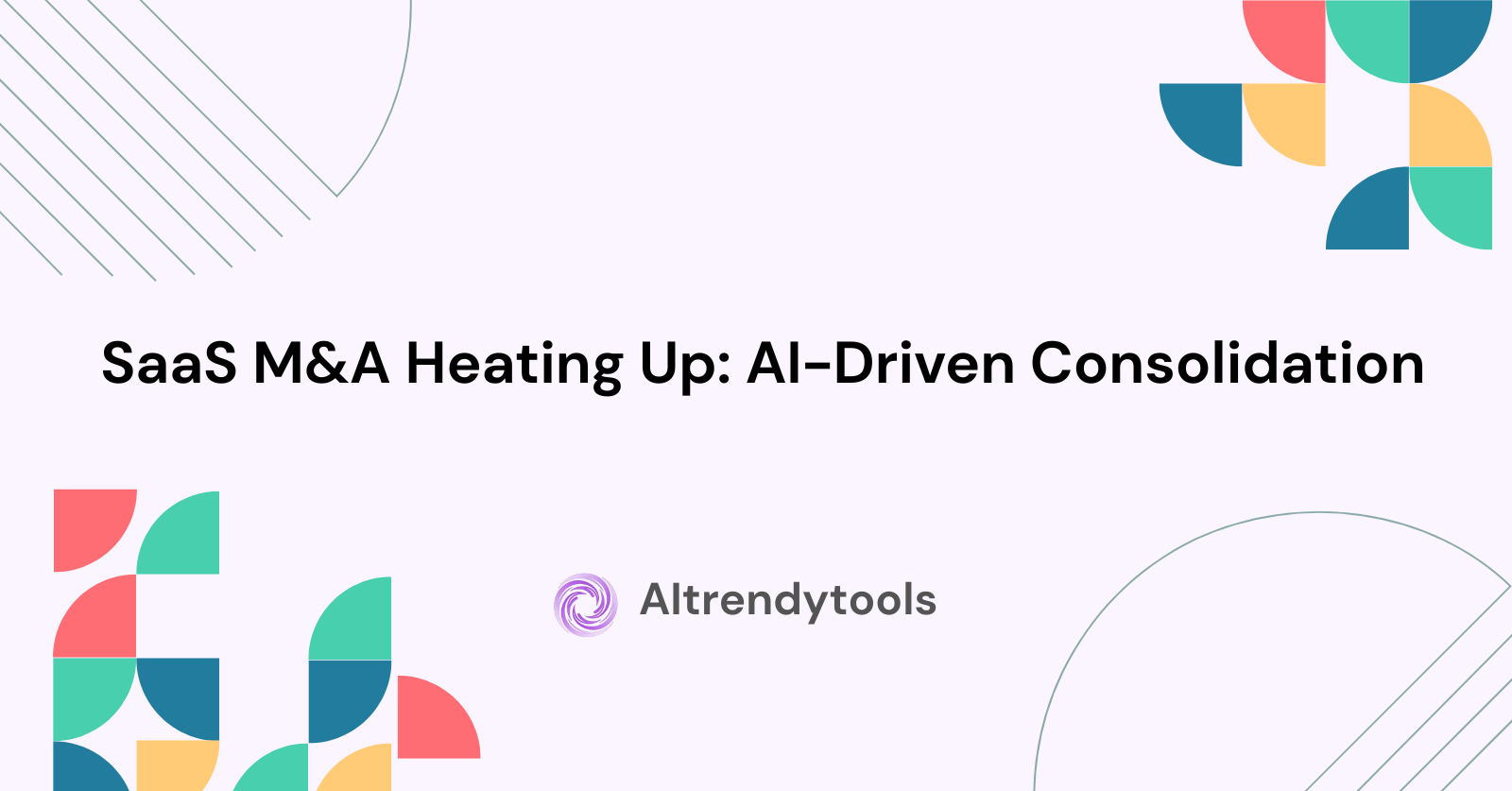🔥 AITrendytools: The Fastest-Growing AI Platform |
Write for usSaaS M&A Heating Up: AI-Driven Consolidation
SaaS M&A transactions jumped 41%. Explore AI-driven consolidation, valuation trends, and why private equity is aggressively pursuing SaaS deals.
Oct 22, 2025
The software-as-a-service industry stands at a critical turning point. Artificial intelligence has emerged as a transformative force reshaping how companies operate, compete, and grow. This shift has triggered an unprecedented wave of merger and acquisition activity across the SaaS landscape.
Market data reveals a compelling story. Transaction volumes have surged more than 41% compared to previous years. Strategic buyers and financial sponsors alike are racing to acquire companies with AI capabilities, modern technology stacks, and scalable business models.
The Perfect Storm Driving SaaS Consolidation
Multiple factors have converged to create ideal conditions for heightened M&A activity. Understanding these dynamics helps explain why consolidation has accelerated so dramatically.
Market maturity has reached a tipping point. Thousands of SaaS companies now compete for customer attention and wallet share. This saturation has made organic growth increasingly expensive and difficult to achieve.
Key drivers accelerating consolidation:
- Market saturation forcing companies to seek inorganic growth
- Valuation corrections creating attractive buying opportunities
- Record levels of private equity dry powder seeking deployment
- Customer demand for integrated solutions over point products
- AI capability gaps requiring immediate solutions
Valuation corrections have created buying opportunities. After years of inflated multiples, more realistic pricing has emerged. Strategic acquirers can now pursue targets at reasonable valuations while still offering attractive returns to sellers.
Capital availability remains strong despite economic headwinds. Private equity firms have accumulated record amounts of dry powder. These funds need deployment, and SaaS companies with recurring revenue models remain attractive investment targets.
AI Integration as a Catalyst for M&A Activity
Artificial intelligence has fundamentally altered the SaaS competitive landscape. Companies without AI capabilities face existential threats. Those with advanced AI features command premium valuations and strategic interest.
Building AI functionality from scratch requires significant investment. Data science talent remains scarce and expensive. Training models demands computational resources and time. Many companies have concluded that acquiring AI capabilities through M&A represents a faster and more cost-effective approach than internal development.
Why companies acquire instead of building AI:
- Shortage of qualified AI talent in the market
- High computational costs for model training
- Time-to-market pressures from competitors
- Proven technology reduces implementation risk
- Access to proprietary datasets and algorithms
AI-powered features have become table stakes. Customers expect intelligent automation, predictive analytics, and personalized experiences. SaaS providers lacking these capabilities risk losing market share to more innovative competitors.
Data accumulation creates powerful moats. Companies with large, high-quality datasets can train superior AI models. Acquiring firms with valuable data assets has become a primary motivation for many transactions.
Vertical SaaS Consolidation Accelerates
Industry-specific software companies have become prime acquisition targets. Vertical SaaS providers offer deep domain expertise and strong customer relationships within defined markets. These characteristics make them attractive to both strategic buyers and financial sponsors.
Healthcare technology companies have seen particularly intense M&A activity. The complexity of healthcare workflows, regulatory requirements, and data standards creates high switching costs. Once established within a provider network, vertical SaaS companies become deeply embedded.
Hot vertical SaaS sectors for M&A:
- Healthcare technology and electronic health records
- Financial services compliance and reporting tools
- Real estate property management platforms
- Construction project management software
- Legal practice management systems
Financial services software providers have also attracted significant attention. Banks, insurance companies, and investment firms require specialized compliance, reporting, and operational capabilities. Companies serving these needs with modern, cloud-based solutions command premium valuations.
Real estate technology represents another hot consolidation sector. Property management, transaction processing, and data analytics tools have proliferated. Forward-thinking acquirers are assembling end-to-end platforms that serve multiple stakeholder groups.
Private Equity's Role in Market Consolidation
Financial sponsors have reentered the SaaS acquisition market with renewed vigor. After a period of caution, private equity firms are deploying capital aggressively. Their strategies have evolved to reflect current market realities.
Platform acquisition strategies have become more sophisticated. Rather than backing single companies, many firms now pursue buy-and-build approaches. They acquire larger platform businesses, then add smaller complementary companies through tuck-in acquisitions.
Private equity SaaS investment strategies:
- Platform-plus-bolt-on acquisition models
- Growth equity minority stakes for flexibility
- Management rollover structures aligning incentives
- Operational value creation through best practices
- Multiple arbitrage across enterprise value scales
Growth equity investments have increased as well. Some private equity firms are taking minority stakes in promising SaaS companies rather than pursuing full acquisitions. This approach provides growth capital while allowing founders to maintain control.
Partnership models between private equity and management teams have matured. Sponsors now recognize that SaaS success requires deep operational expertise. Deal structures increasingly include significant management rollover equity and alignment mechanisms.
Enterprise Buyers Pursue Strategic Consolidation
Large technology companies are using M&A to expand their product portfolios rapidly. Cloud infrastructure providers, enterprise software giants, and digital transformation leaders all see acquisition as essential to their growth strategies.
Cross-selling opportunities drive many strategic transactions. Companies with large customer bases can introduce acquired products to existing accounts. This distribution advantage creates immediate revenue opportunities that justify premium acquisition prices.
Strategic buyer motivations:
- Cross-sell opportunities to existing customer bases
- Competitive defense against rival acquisitions
- Talent acquisition for scarce technical skills
- Geographic expansion into new markets
- Technology stack modernization initiatives
Competitive defense motivates other acquisitions. When rivals acquire innovative companies, market leaders feel pressure to respond. This dynamic has created acquisition races in several software categories.
Talent acquisition plays an often-overlooked role. Acquiring companies with exceptional engineering teams provides immediate access to scarce skills. The cost per employee through acquisition can be lower than recruiting, especially for specialized capabilities.
SaaS Valuation Trends in the M&A Market
Pricing dynamics have shifted significantly. The days of 20x revenue multiples for unprofitable SaaS companies have passed. More disciplined valuation frameworks now govern transactions.
Profitability matters more than ever. Companies demonstrating positive cash flow or clear paths to profitability command substantially higher multiples. Acquirers have tired of funding losses with hopes of eventual margin expansion.
Metrics driving SaaS valuations today:
- EBITDA margins and path to profitability
- Revenue growth rate and sustainability
- Net revenue retention above 110%
- Customer acquisition cost payback periods
- Lifetime value to CAC ratios
Growth rates remain important but are evaluated more critically. Acquirers now distinguish between efficient and inefficient growth. Companies spending $2 to acquire $1 of annual recurring revenue face valuation discounts.
Retention metrics significantly impact valuations. Net revenue retention above 110% signals strong product-market fit and expansion potential. Gross retention below 90% raises concerns about product quality and customer satisfaction.
Technology Stack Modernization Through Acquisition
Legacy systems create significant competitive disadvantages. Companies built on outdated architectures struggle to innovate quickly. Many organizations use M&A to accelerate their technology modernization journeys.
Cloud-native acquisitions help traditional software companies transform. Firms still running on-premises infrastructure seek targets with modern, scalable cloud architectures. These acquisitions provide blueprints for platform migration while adding new revenue streams.
Technology capabilities driving acquisition premiums:
- Cloud-native architecture built for scale
- API-first design enabling ecosystem development
- Mobile-first user experiences
- Microservices architecture for flexibility
- Modern security and compliance frameworks
API-first designs attract strategic interest. Companies that built developer-friendly integration capabilities enable ecosystem development. Acquirers recognize that open architectures facilitate faster innovation and broader market adoption.
Mobile-first capabilities fill important gaps. Desktop-centric software companies pursue mobile-native targets to serve changing user preferences. The shift toward mobile workflows has created urgent needs that M&A can address quickly.
Geographic Expansion via Strategic Acquisitions
International growth through acquisition has accelerated. Rather than building local presence organically, many SaaS companies now acquire regional players. This approach reduces time to market and regulatory risk.
European acquisitions by North American companies have increased. Buyers gain immediate GDPR compliance, local customer relationships, and European data residency capabilities. The regulatory complexity of serving European customers makes acquisition particularly attractive.
Regional expansion priorities:
- Europe for regulatory compliance and market access
- Asia-Pacific for high-growth emerging markets
- Latin America for underserved digital transformation
- Middle East for government and enterprise opportunities
Asia-Pacific markets present unique opportunities. Local SaaS companies understand regional business practices, languages, and integration requirements. Western companies seeking Asian expansion increasingly view acquisition as the optimal entry strategy.
Emerging market targets offer high growth potential. Countries with rapidly digitizing economies provide significant expansion opportunities. Acquiring established players in these markets provides instant credibility and distribution.
Post-Merger Integration Challenges and Solutions
Successful acquisitions require effective integration planning. Many deals fail to deliver expected value due to poor execution. Companies that excel at post-merger integration gain significant competitive advantages.
Cultural alignment represents a critical success factor. SaaS companies often have strong engineering-driven cultures. When acquirers impose heavy processes or bureaucracy, talent attrition follows.
Common integration pitfalls to avoid:
- Forcing cultural changes too rapidly
- Delaying technology platform decisions
- Poor customer communication creating uncertainty
- Losing key talent during transition periods
- Failing to capture planned cost synergies
Technology integration demands careful planning. Combining product roadmaps, reconciling technical debt, and unifying data architectures all present challenges. Companies that move too quickly risk operational disruption.
Customer communication requires special attention. Acquisition announcements create uncertainty. Users worry about product direction, pricing changes, and support quality. Proactive, transparent communication helps maintain customer confidence during transitions.
Regulatory Considerations Shaping Deal Structures
Antitrust scrutiny has intensified globally. Competition authorities are examining technology acquisitions more carefully. This heightened attention affects deal timing, structure, and success probability.
Data privacy regulations influence acquisition targets and processes. Due diligence must now include detailed assessments of data handling practices. Non-compliance issues can derail transactions or reduce valuations substantially.
Key regulatory considerations:
- Antitrust review timelines and approval risks
- Data privacy compliance across jurisdictions
- Industry-specific licensing requirements
- Export control restrictions on technology
- Foreign investment screening processes
Industry-specific regulations create additional complexity. Healthcare, financial services, and government-facing SaaS companies operate under strict regulatory frameworks. Acquirers must ensure compliance continuity throughout integration.
The Role of AI in M&A Deal Execution
Artificial intelligence has transformed how companies identify, evaluate, and execute acquisitions. Modern deal teams leverage AI tools throughout the transaction lifecycle.
Target identification uses machine learning algorithms. Rather than manually researching potential acquisitions, teams now employ AI systems that analyze thousands of companies. These tools identify strategic fits based on multiple criteria, surfacing opportunities that might otherwise be missed.
AI applications in M&A processes:
- Machine learning for target identification and screening
- Natural language processing for document review
- Predictive analytics for valuation modeling
- Automated financial statement analysis
- Risk detection through pattern recognition
Due diligence efficiency has improved dramatically. AI-powered document review accelerates contract analysis, financial statement examination, and risk identification. Tasks that previously required weeks now take days.
Valuation modeling incorporates predictive analytics. Machine learning models analyze comparable transactions, project future performance, and identify value creation opportunities. These insights help acquirers develop more accurate pricing models and integration plans.
Future Outlook for SaaS M&A Activity
Market conditions suggest continued consolidation ahead. Several trends point toward sustained high transaction volumes.
Artificial intelligence will remain a primary driver. Companies will continue acquiring AI capabilities rather than building them internally. The pace of AI innovation makes ongoing acquisition activity likely.
Trends shaping future M&A activity:
- Continued AI capability acquisitions
- Profitability pressure driving consolidation
- Platform assembly strategies accelerating
- Cross-border transactions increasing
- Smaller deal sizes with higher volumes
Margin pressure will accelerate consolidation. Public market investors demand profitability from SaaS companies. Smaller firms struggling to achieve efficient unit economics will seek acquisitions as exit paths.
Customer preferences for integrated solutions will persist. Businesses want comprehensive platforms rather than point solutions. This demand will drive strategic buyers to assemble broader product portfolios through acquisition.
Strategic Recommendations for SaaS Companies
Companies on both sides of potential transactions should prepare strategically. Whether seeking to acquire or be acquired, certain actions improve outcomes.
Sellers should focus on fundamental business strength. Strong unit economics, high retention rates, and clear differentiation attract premium offers. Companies that operate efficiently and grow sustainably position themselves advantageously.
Preparation strategies for potential sellers:
- Optimize key performance metrics consistently
- Build defensible AI capabilities and features
- Document scalable processes and operations
- Strengthen customer retention programs
- Clean up technical debt proactively
Building AI capabilities creates optionality. Even modest investments in machine learning, automation, or predictive features enhance strategic value. These capabilities signal innovation and future readiness to potential acquirers.
Buyers should develop clear acquisition strategies. Random opportunistic deals rarely create value. Companies with defined criteria, integration playbooks, and disciplined processes achieve better results.
Key Metrics Driving M&A Valuations
Understanding which metrics matter most helps companies position themselves effectively. The factors that drive valuations have evolved significantly in the current market environment.
Annual recurring revenue growth demonstrates market opportunity. Companies expanding at 40% or more annually signal large addressable markets. This growth trajectory justifies higher valuation multiples when combined with efficient economics.
Critical valuation metrics for SaaS companies:
- Annual recurring revenue growth rate
- Customer acquisition cost payback period
- Lifetime value to CAC ratio
- Net revenue retention percentage
- Rule of 40 score (growth + margin)
- Gross margin percentages
Customer acquisition cost payback periods indicate efficiency. Companies recovering acquisition costs within 12 months demonstrate strong product-market fit. Longer payback periods raise concerns about sustainable growth and capital efficiency.
Lifetime value to customer acquisition cost ratios reveal profitability potential. Ratios above 3:1 suggest healthy economics. Companies approaching 5:1 or higher demonstrate exceptional efficiency that commands premium valuations in competitive bidding situations.
Frequently Asked Questions
How is AI impacting SaaS M&A valuations?
AI capabilities significantly increase SaaS company valuations by demonstrating innovation, improving operational efficiency, and creating competitive differentiation. Companies with integrated AI features typically command 20-30% premium multiples compared to traditional SaaS providers.
What makes a SaaS company an attractive acquisition target?
Strong unit economics, high net revenue retention above 110%, clear product differentiation, scalable technology infrastructure, and proven AI integration make companies attractive. Profitability or a clear path to positive cash flow has become essential.
Why are private equity firms so active in SaaS M&A?
Private equity firms favor SaaS businesses for their recurring revenue models, high gross margins, and predictable cash flows. The buy-and-build strategy allows them to create value through consolidation, operational improvements, and multiple arbitrage.
How long does a typical SaaS M&A transaction take?
Most SaaS acquisitions require 3-6 months from initial discussions to closing. This timeline includes preliminary discussions, due diligence, negotiations, regulatory approvals, and final integration planning. Complex deals involving regulatory scrutiny can extend to 9-12 months.
What are the biggest risks in SaaS acquisitions?
Key risks include customer churn during ownership transition, talent attrition from cultural misalignment, technology integration challenges, regulatory compliance issues, and failure to achieve projected synergies. Proper due diligence and integration planning mitigate these risks.
Conclusion
The SaaS industry continues its transformation through an unprecedented wave of consolidation. AI-powered capabilities, market maturation, and customer demands for integrated solutions have created ideal conditions for sustained M&A activity.
Companies that recognize these trends and position themselves strategically will thrive. Understanding valuation drivers, building defensible capabilities, and maintaining operational excellence prove essential whether pursuing growth through acquisition or seeking liquidity through sale.
The intersection of SaaS business models and artificial intelligence capabilities has created unique opportunities. Market participants who act decisively while maintaining financial discipline will capture outsized value. This consolidation wave presents challenges, but for prepared organizations, it offers tremendous potential for growth, innovation, and market leadership in the rapidly evolving software landscape.
🚀 Submit Your Tool to Our Comprehensive AI Tools Directory
Get your AI tool featured on our complete directory at AITrendytools and reach thousands of potential users. Select the plan that best fits your needs.





Join 30,000+ Co-Founders
Related Blogs
TechMapz Com: 7 Reasons It's Your Best Tech Hub
Discover TechMapz com the ultimate technology hub for gadget reviews, AI trends, cybersecurity tips, and tech news. Explore features that make it stand out in 2025.
Sci Hub: 10+ Free Alternatives to Access Research Papers
Discover Sci Hub alternatives and 10+ legal ways to access research papers free. Complete guide to scientific journals, open access, and academic resources.
Picverse AI Review: Create Stunning Images in Seconds
Discover how Picverse AI transforms text into stunning visuals. Features, pricing, pros & cons everything you need to know about this AI image generator.
Submit Your Tool to Our Comprehensive AI Tools Directory
List your AI tool on AItrendytools and reach a growing audience of AI users and founders. Boost visibility and showcase your innovation in a curated directory of 30,000+ AI apps.





Join 30,000+ Co-Founders

